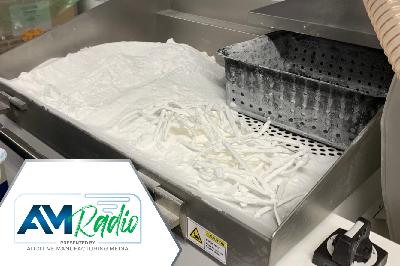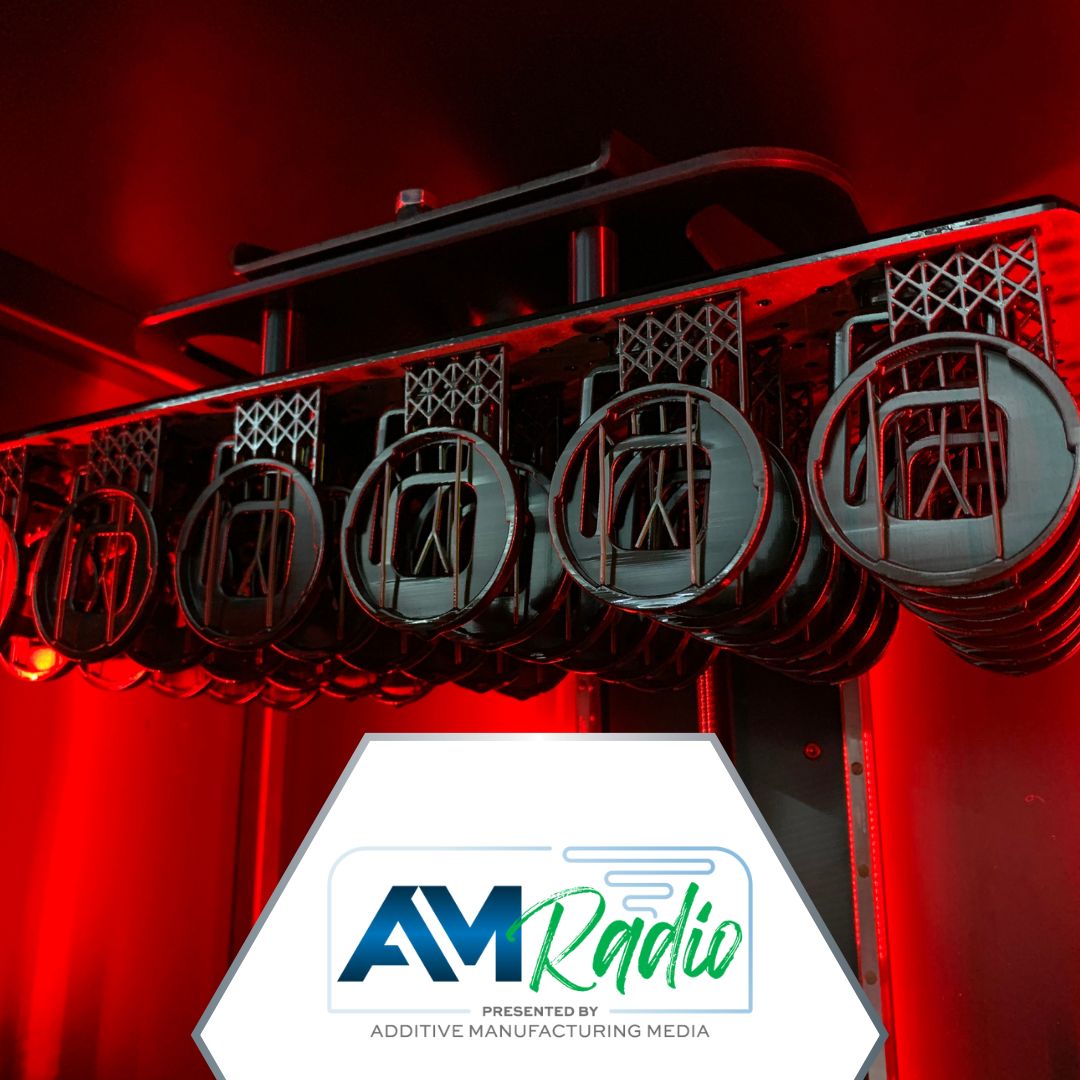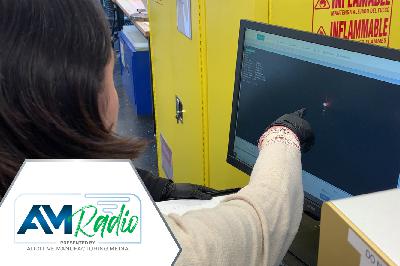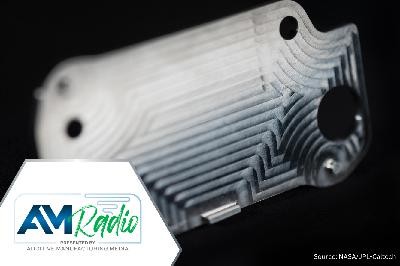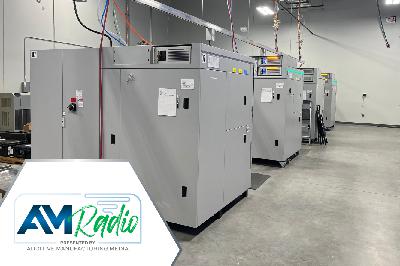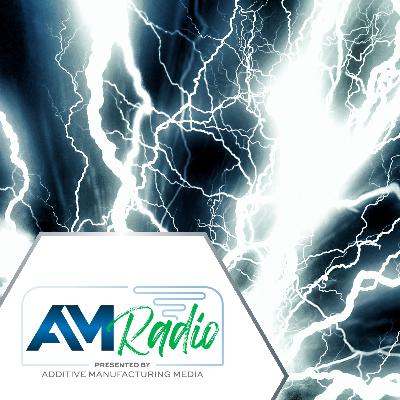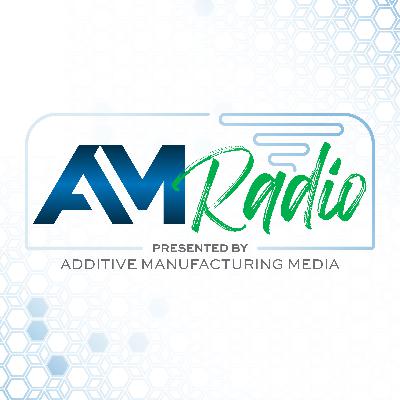Discover AM Radio
AM Radio

AM Radio
Author: Additive Manufacturing Media
Subscribed: 20Played: 206Subscribe
Share
Description
This 3D printing podcast doesn’t shy away from asking the big questions about where additive manufacturing is currently and where it is headed.
On AM Radio, Additive Manufacturing Media hosts share stories of companies succeeding with 3D printing today; talk about emerging trends; and discuss the future opportunities and potential for AM in the context of the larger manufacturing landscape.
On AM Radio, Additive Manufacturing Media hosts share stories of companies succeeding with 3D printing today; talk about emerging trends; and discuss the future opportunities and potential for AM in the context of the larger manufacturing landscape.
60 Episodes
Reverse
Postprocessing is a necessary part of the additive manufacturing (AM) workflow in almost every instance, because 3D printing alone rarely yields a finished part ready for use. Depending on the materials and processes they choose, AM adopters have to account for depowdering, curing, heat treat, cleaning, dyeing, tumbling, machining and many other post-print operations. Coupled with the high-mix, low-volume production typical in AM, such steps are difficult to automate or optimize — leading many companies to develop innovative and often secretive internal processes. In this episode of AM Radio, Stephanie Hendrixson, Peter Zelinski, Jessica Pompili and Jodee McElfresh share examples of how additive manufacturers solve their varied postprocessing challenges and seek to answer some of the questions around these critical steps. Thanks to listeners who sent questions, left comments or lent their expertise to this episode, including Matt Havekost, Rick Beddoe, Miguel Valenzuela, Konstantin Rybalcenko, Rey Chu, John Whalen and those who responded anonymously. Find photos, related links and the transcript for this episode on AdditiveManufacturing.Media. This episode is brought to you by Additive Manufacturing Media. Never miss a story. Mentioned in this episode: Our calls for questions — and discussion— around postprocessing on LinkedIn Meet Jessica Pompili, Additive Manufacturing Media assistant editor A conversation on finishing's role in AM with Products Finishing editor-in-chief Scott Francis Our story on ATI's new Florida facility Article on Rivelin's robotic machining technology from Derek Korn, editor-in-chief of sister brand Production Machining Video on how the Rivelin solution works AM-Flow's sorting solution for mixed part batches The Cool Parts Show LIVE: Special 5-Year Anniversary Episode with support removal "hatch" 3D Printed Metal Component for CNC Machining Center | The Cool Parts Show #47 with sacrificial powder removal feature Micro Factory's enclosed mSLA system The modular JENI production system from Photocentric Solvent recycling technology company CBG Biotech How metal injection molding and metal binder jetting coexist at Smith Metal Products The metal binder jetting workflow at Freeform Technologies An example of a thin-fin cold plate produced by Conflux Technology Resolution in vat photopolymerization and smoothing techniques developed at the Technical University of Denmark
A question from an audience member about competing production rates for a forged metal part that might be made through additive manufacturing instead got Pete Zelinski thinking about production rate in general, and what this rate does and does not tell us about productivity overall. Additive can win a production “race.” An example involving a 1,000-piece production run of parts otherwise made through molding was documented by Formlabs (more info below). However, is a head-to-head comparison like this the measure by which additive must succeed? Pete explores this question. Find photos, related links and the transcript for this episode on AdditiveManufacturing.Media. Mentioned in this episode: From Formlabs, 3D printing vs. injection molding for a 1,000-piece run. Our report at Big Metal Additive on directed energy deposition for Navy projectiles. Subscribe to The BuildUp, our twice-weekly Additive Manufacturing newsletter.
Formnext 2024 lived up to its reputation as additive manufacturing’s largest trade show, attracting more than 34,000 attendees to 54,000 m2 of exhibit space. It was also large in the sense of showcasing just how big 3D printing can go, with plenty of showpieces and demos running to illustrate the current scale of large-format additive manufacturing (LFAM) technology. But beneath the robotic arms and towering prints, there were also plenty of new machine introductions, software advances and application examples. Over the course of their time at the show, AM Radio cohosts Peter Zelinski and Stephanie Hendrixson noted more semiconductor applications than ever before, an increased use of tungsten, software developments aimed at solving AM’s design bottleneck, various approaches to cutting cost per part, and indications that additive manufacturing has crossed various tipping points expanding where the production method makes sense, and is on trajectory to continue that advance. In this episode of the AM Radio podcast, hear observations from the show floor and takeaways for additive manufacturers. Find photos, related links and the transcript for this episode on AdditiveManufacturing.Media. This episode is brought to you by Additive Manufacturing Media. Never miss a story.
Additive manufacturing and robots are parallel technologies, both digitally enabled tools for manufacturing that are advancing in adoption. But they also enable each other. 3D printing can provide the grippers, end effectors and other specialized tooling that robots require to serve production. And robots are driving AM forward as well. Collaborative robots or cobots are being used to tend 3D printer farms, sometimes mounted on autonomous guided vehicles (AGVs) for a fully mobile, as well as automated, solution. And robots are opening opportunities for larger and more complex part production, by providing the motion for a growing number of large format additive manufacturing (LFAM) systems. In this episode of AM Radio, Gardner Business Media Robots & Autonomy editor Julia Hider joins Stephanie Hendrixson and Pete Zelinski to discuss how AM and robots interact, and specific examples of this interaction. Find photos, video, related links and the transcript for this episode on AdditiveManufacturing.Media. This episode is brought to you by The Cool Parts Show. Sign up for All Access. Mentioned in this episode: Julia's Robots and Autonomy reporting How Savage Automation produces 3D printed end effectors for injection molders Rapid Robotics and Robots as a Service (RaaS) Large, 3D printed grippers used by BMW to handle car parts Pete's Formnext robot gripper encounter (first photo) Julia’s story on the Advanced Robotics for Manufacturing (ARM) Institute, home of the 3D printed LEGO gripper More advanced and additive manufacturing work happening in Pittsburgh How AM enables cobot automation for Thyssenkrup Bilstein Examples of 3D printed cobot tooling provided by EMI Corporation, as seen in the Universal Robots booth at NPE Evco Plastics' Markforged printer cell, tended by a cobot informed by email Soft grippers and their potential usefulness for handling 3D printed parts The Mosaic Array 3D printer cell, enclosing four individual printers tended by one gantry system Javier, Ford Motor Company's AGV-mounted cobot for tending polymer printers Branch Robotics' mobile robot for tending a farm of potentially dissimilar 3D printers How Alquist 3D supports both on-site construction and in-house serial production with robot 3D printing A large casting replacement produced by Lincoln Electric using robot-based wire arc additive manufacturing (WAAM) What Additive Engineering Solutions (AES) is learning in the transition from gantry- to robot-based LFAM How Double D plans to build next-generation horse trailers with robot-enabled 3D printing
The 2024 edition of IMTS – The International Manufacturing Technology Show welcomed more than 89,000 attendees to Chicago last week. While only a portion of the show’s 1,500 exhibitors were offering additive manufacturing equipment or services, AM nevertheless had a significant footprint at this show. Conversations with speakers, exhibitors and attendees revealed insights about where additive is finding traction now, and where it is heading next. In this episode of AM Radio, I talk with Pete Zelinski about equipment launches during the show, advances in usability and accessibility, AM’s role in the casting supply chain, the increased presence of service providers, and how the next “phase” of AM will look different. Find photos, related links and the transcript for this episode on AdditiveManufacturing.Media. This episode is brought to you by Additive Manufacturing Media. Never miss a story. Mentioned in this episode: LinkedIn feeds: Stephanie | Pete Videos from the show: Robot Machining and Robot DED Video: Scanning for Fast Model Capture and Validation of AM Parts More to come — subscribe to The BuildUp Markforged FX10 Metal Kit 3D Systems Titan EXT 800 pellet printer Formalloy, developer of the DED Smart Path scanning module Stratasys F3300 and Origin 2 One Click Metal (video to come) EOS dual setup system for laser powder bed fusion Mazak hot wire hybrid deposition machine Würth Additive Group’s DIS platform (video to come) How DIS integrates with Raise3D's resin 3D printers A test of Spee3D's cold spray technology in expeditionary manufacturing Meltio M600 DED machine Colibrium Additive (formerly GE Additive) and the impact of binder strength for production Oak Ridge National Laboratory integrated machining/DED system Perspective on hybrid manufacturing from Hybrid Manufacturing Technologies, which showcased its 45° deposition head More on service providers 3DEO and Forecast 3D/GKN Additive Desktop Metal Studio System Nikon SLM Solutions on continuing adoption: Here is an example (valves) HP 3D printing
Stephanie Hendrixson shares observations from her visit to learn more about two different manufacturing institutes under the umbrella of Carnegie Mellon University. First, she visited the lab facilities at Mill 19, a refurbished steel mill site, used by the Manufacturing Futures Institute. The MFI aims to accelerate the digital transformation of manufacturing, through work that includes things like robotics, digital twins and generative design as well as AM. She also learned about the Next Manufacturing Center, CMU's additive-focused research institute seeking to solve increasingly specific 3D printing problems— including how to model and avoid spatter in laser powder bed fusion. Find photos, related links and the transcript for this episode on AdditiveManufacturing.Media. This episode is brought to you by Additive Manufacturing Media. Never miss a story. Want to be the first to see the episodes of The Cool Parts Show we created with Carnegie Mellon? Sign up for our ALL ACCESS newsletter for fans of the show. Mentioned in this episode: Stephanie's article about additive manufacturing and Carnegie Mellon University More about the solar array installed at Mill 19 Article from Solar Power World Mill 19 The Manufacturing Futures Institute and Next Manufacturing Center
In this follow-up to episode #51 of AM Radio, Dr. Tim Simpson joins Stephanie Hendrixson and Pete Zelinski in the studio to talk more about how NASA is implementing and shaping additive manufacturing. As part of an intergovernmental personnel act (IPA) assignment, Dr. Simpson has spent the last two years deployed within NASA helping to advance additive use cases and connect AM users within the organization. In this episode, he shares insights from this work including NASA's collaborative relationship with commercial space; its role in studying AM fundamentals and providing testing resources; missions currently using the technology; and where additive will enable NASA to go next. Find photos, related links and the transcript for this episode on AdditiveManufacturing.Media. This episode is brought to you by Additive Manufacturing Media. Never miss a story. Mentioned in this episode: Episode #51 (PART 1) The Cool Parts Show episodes featuring: "Evolved" bracket structures for the EXCITE mission, seen at Goddard Space Flight Center Lattices for the Mars sample return mission, seen at the Jet Propulsion Lab The RAMPT thrust chamber assembly, filmed at Marshall Space Flight Center Other resources: Additive Manufacturing for Rocket Propulsion Applications by Paul Gradl NASA 6030 standard Work from other folks Tim mentioned: Scott Roberts Michael Schein
Additive Manufacturing Media editors have had the chance to visit three different NASA facilities: the Goddard Space Flight Center, Jet Propulsion Laboratory and Marshall Space Flight Center. Pete Zelinski and Stephanie Hendrixson learned and reported on how 3D printing is being used to fulfill NASA missions through parts like a generatively designed bracket, lightweight titanium lattices and a multimaterial thrust chamber made with two different processes. But where do these parts fit within NASA's broader mission, and what is the role of additive manufacturing at NASA? In this episode, part 1 of a 2-part series, Pete and Stephanie discuss what it's like to visit NASA and the observations they gleaned from being on site. (Make sure to subscribe and join us for Part 2, featuring AM Radio cohost and NASA system design innovator Dr. Tim Simpson.) Find photos, related links and the transcript for this episode on AdditiveManufacturing.Media. This episode is brought to you by THE BUILDUP. Mentioned in this episode: The Cool Parts Show episodes featuring: "Evolved" bracket structures for the EXCITE mission, seen at Goddard Space Flight Center Lattices for the Mars sample return mission, seen at the Jet Propulsion Lab The RAMPT thrust chamber assembly, filmed at Marshall Space Flight Center More on these NASA initiatives: EXCITE Balloon Mission Mars Sample Return RAMPT Our previous episode on qualification and standards in AM, including NASA 6030 3D printed brackets on the Juno spacecraft
When we first covered Model No. in 2020, the company was manufacturing furniture on its own large-format 3D printers, built to designs directly manipulated by customers through parametric options available on its website. Four years later, production looks a bit different. Gone is the user-facing design tool, as the company has discovered that conversation with customers is the more effective way to arrive at the right designs for its clients. More colors and materials are offered today, in part because of a circular economy-focused project that Model No. completed with several partners. And there's one important change to how furniture is made--listen to the episode to learn how (and why) the company's 3D printing capacity has evolved in the last few years. Find photos, related links and the transcript for this episode on AdditiveManufacturing.Media. This episode is brought to you by Additive Manufacturing Media. Never miss a story. Mentioned in this episode: The 2024 update article about Model No. Stephanie's original 2020 story about the company Model No. as an example of a manufacturer producing on its own 3D printer in this AM Radio podcast episode from 2021 More on the “AM Factory” concept More on the EXT 1070 Titan Pellet 3D printer available from 3D Systems, the platform used by Model No. The episode of The Cool Parts Show featuring Eaton, another company applying the Titan platform for large-format 3D printing of innovative materials — in this case for aerospace parts Stephanie's Model No. table on LinkedIn and X
We are trying something new on the podcast! Whenever one of us on Additive Manufacturing Media pays a visit to a manufacturer for the first time, we want to talk about the trip as soon as we return. Why keep this recap to ourselves? In this episode of AM Radio, here is Stephanie Hendrixson getting the full download just after I paid a visit to Innovative 3D Manufacturing in Franklin, Indiana. Innovative does contract production using 12 laser powder bed fusion machines, all from Renishaw. Just part of what struck me is this company’s connection to foundry work — not just in terms of process, such as workholding technique, but also in terms of business opportunity, because Innovative is getting work due to foundry leadtime challenges. Listen to our conversation above, or on your favorite podcast app. And for even more on Innovative, read the article I wrote, which is linked below. - Peter Zelinski, editor-in-chief, Additive Manufacturing Mentioned in this episode: Pete’s companion article on Innovative 3D Manufacturing, including photos from inside this facility Neighborhood 91, an AM industrial park in Pittsburgh More examples of production AM contract manufacturers
What is qualification, and what does it entail for additive manufacturing applications? In this episode of AM Radio, Dr. Tim Simpson joins Additive Manufacturing Media editors Pete Zelinski and Stephanie Hendrixson to talk about various issues around qualification in AM, including: the difference between qualification and certification; the expense of qualification activities; how standards are developed; and the opportunities additive can realize with qualified procedures. Find related links and the transcript for this episode on AdditiveManufacturing.Media. This episode is brought to you by The Cool Parts Show. Mentioned in this episode: How RP+M manufactures aerospace parts for major OEMs and helped to create NCAMP Document 89085 NASA STD 6030 American Welding Society's AWS D20 ASTM standards on additive manufacturing SAE's AMS standards for additive manufacturing FDA's Technical Considerations for Additive Manufactured Medical Devices Würth Additive Group's work to develop digital inventory solutions Series from The Barnes Global Advisors on qualification in the rail, defense and space industries Another Giant Leap for AM — New Standards by Tim Simpson
In the last episode of AM Radio for 2023, hosts Pete Zelinski, Stephanie Hendrixson and Fiona Lawler look back on Additive Manufacturing Media's top 10 stories by pageviews for the year. The list reveals some interesting trends including the ramp up in additive manufacturing "factories," additive adoption that necessitates more sophisticated downstream processing, and a heavy emphasis on metal 3D printing. In the second half of the show, the hosts share their favorite stories, regardless of ranking, written by someone else. Find photos, related links and the transcript for this episode here. This episode is brought to you by Additive Manufacturing Media. Never miss a story. Mentioned in this episode: Top 10 stories by pageviews for 2023 AM Factory issue of Additive Manufacturing Magazine United Performance Metals Is the One-Stop Build Plate Shop for Production AM 3D Printing Project to Advance Medical Device Customization New Zeda Additive Manufacturing Factory in Ohio Will Serve Medical, Military and Aerospace Production Next-Gen Horse Trailers to Be Built With Robotic 3D Printing ConocoPhillips Sees Oil and Gas Supply Chain Opportunity With Additive Manufacturing 6 Considerations When Launching an Additive Startup
The world's largest trade show for additive manufacturing technology featured more than 800 exhibitors across the entire AM value chain. Additive Manufacturing editors Peter Zelinski and Stephanie Hendrixson discuss what they learned and discovered at the event in this episode, including the rise of copper, the introduction of new processes for 3D printing in metals, equipment upgrades that don't rely on hardware, reduced barriers to entry for AM and much more. Find photos, related links and the transcript for this episode on AdditiveManufacturing.Media. This episode is brought to you by THE BUILDUP. Mentioned in this episode: Formnext Coverage of the 2022 show Reinforce3D's postprocess reinforcing technique Horizon Microtechnologies' functional coatings Machine Improvements That Don’t Rely on Hardware Renishaw's Tempus system for simultaneous laser scanning and recoating EOS's Smart Fusion for controlling the melt pool temperature AI Build's toolpath and slicing software for robot-based systems Dyndrite's LPBF Pro New Metal Processes Additec's Liquid Metal Jetting Process, now part of a hybrid machine also offering laser wire DED and machining Valcun's Minerva machine for Molten Metal Deposition Cold Metal Fusion Headmade Materials MIMPlus Nexa3D The Rise of Copper 6K Additive's Unimelt process Metal Powder Works' method for producing metal powder from solid stock Lithoz's CeraFab Multi 2M30 for multimaterial parts Lowering the Barriers to Entry Evolve Additive Solutions STEP Parts Now (more about how STEP works) Nanodimension Giga machines 3D Systems SLS 300 Formlabs Fuse Blast for automated SLS depowdering Freemelt eMelt production platform for EBM AM Navigator from Siemens, Dyemansion, HP, ForwardAM, BASF, EOS Castor software for identifying AM parts Resurgence of Tooling Focus Demo part formed on 3D printed tooling with material from Airtech, printed on a Hans Weber machine Machine tool builder and now LFAM printer supplier Breton Markforged FX10 3D printer HP's partnership with INDO-MIM Tool Changing in AM Stratasys F3300 with four extruder heads nLight programmable laser Prolay FFF printer for Progressive Layer Thickness Manufacturing (PLTM)
Additive manufacturing "factories" and other facilities that have been built from the ground up to serve this process are becoming increasingly common, but a purpose-built space is not a necessity for successfully applying AM. Stephanie Hendrixson and Fiona Lawler discuss Fiona's recent trip to visit a newly established Protolabs facility dedicated to laser powder bed fusion, and swap stories of other AM spaces--from a 3D printer tucked under the stairs to a rented office space all the way to buildings acquired or built just for production additive manufacturing. This episode is brought to you by AM Media. Subscribe and learn more at www.additivemanufacturing.media. See photos and find the transcript for this episode at on our website. Mentioned in this episode: Fiona Lawler's article on her visit to Protolabs’ new Raleigh, North Carolina, metal additive manufacturing facility Slice Mfg, medical implant manufacturer in Akron, Ohio OMG Additive, Cincinnati-based startup founded by JP Kinerk CATCH, the Charlotte Advanced Technology Collaboration Hub located within Siemens Energy A tour through Stratasys Direct Manufacturing’s Belton, Texas, facility Würth Additive Group (feature article forthcoming—subscribe to The BuildUp to see it first!) Sintavia's Hollywood, Florida, facility designed for equipment upgrades More from Formnext Forum Austin, including what we learned touring Cumberland Additive and EOS Pittsburgh's Neighborhood 91 campus for additive manufacturing
Sporting goods, tooling, integration with conventional processes, multi materials — in this episode of AM Radio, Jodee McElfresh and Pete Zelinski discuss the topics that have been popular on the Additive Manufacturing Media website and social media recently. Mentioned in Episode: Snarr3D's 3D printed golf putter shafts article and LinkedIn post ActivArmor's 3D printed casts The Cool Parts Show episode and LinkedIn post Jodee's post with the EOS 3D printed top Pete's post about the America Makes MMX event InssTek's rocket nozzle made through DED Three major phases in the advance of additive manufacturing Airtech's 3D printed automotive tool Humtown's sand 3D printed dinosaur egg video and article Bauer Hockey’s personalized equipment RePliForm's electroplating of polymer 3D printed parts article and LinkedIn post Subscribe to The BuildUp, our twice weekly newsletter about all things additive.
Formnext Forum Austin, the first Formnext event to be held in the United States, concluded August 30 after two full days of conference programming dedicated to industrial additive manufacturing. The event is jointly organized by Mesago Messe Frankfurt, AMT—The Association For Manufacturing Technology, and Gardner Business Media, the publisher of Additive Manufacturing Media. Along with sessions on additive end markets, production applications, AM technology and design for additive manufacturing (DFAM), Formnext Forum included a lively expo featuring nearly 80 exhibitors plus The Cool Parts Showcase. Attendees also had access to several facility tours and networking opportunities. The event drew more than 900 attendees, including the editors of Additive Manufacturing. Pete Zelinski, Fiona Lawler and Stephanie Hendrixson recorded this conversation for AM Radio shortly after the event. Find photos and the transcript of this episode in this blog post. This episode is brought to you by The Cool Parts Show. Mentioned in this episode: Formnext Forum Austin Formnext Chicago, coming in spring 2025 The Cool Parts Show bonus episode on Wilson's airless basketball 6K's lifecycle assessment of its Unimelt process for creating metal powders Seurat's business model based on developing and using high-throughput laser powder bed fusion The Cool Parts Showcase finalists and the 2023 winning parts Designfusion's work with startup Rekkie, an example of a small company taking advantage of 3D printing's flexibility for product launches Carolyn Seepersad's research on customizable, 3D printable medical devices Eaton Aerospace and the additive work being undertaken in South Carolina Tangible Solutions (now Marle Tangible) and their journey to AM production Elementum 3D's metal matrix composite and A6061 aluminum 3DXTECH's Gearbox HT2 3D printer Other examples of Fabrisonic's successes with ultrasonic additive manufacturing Additive Engineering Solution's production of 3D printed submarine fairings for Dive Technologies A past podcast episode including our discussion of LFAM
Succeeding with additive manufacturing from a technical perspective has to be followed by succeeding with AM from an organizational perspective. Additive is a different production process entailing different enterprise, workflow and costing considerations, not to mention different personnel, communication and cultural considerations as well. Dr. Tim Simpson and Peter Zelinski talk about all of this: how to organize for success when additive manufacturing is the production process. This episode of AM Radio is brought to you by Formnext Forum Austin. Mentioned in this episode: Additive manufacturing provider Keselowski Advanced Manufacturing New major Zeda additive manufacturing facility opening in Ohio Our coverage of the new AM factories VulcanForms’ approach to digital production CIMP-3D, the facility Tim Simpson co-leads at Penn State Collins Aerospace’s use of AM to protect intellectual property Episode of AM Radio all about bridge production Eaton AM facility, including its strategy for adapting to technology advance Aniwaa graphic categorizing known makers of 3D printers Previous AM Radio episodes featuring Tim Simpson on the topics of cybersecurity | misperceptions of AM | supply chain | sustainability | the AM workforce Subscribe to THE BUILDUP, our newsletter on 3D printing for industrial production
As a “born digital” technology, additive manufacturing intrinsically relies on data, more so than any other manufacturing process. That data reliance potentially exposes AM users to data security and cybersecurity issues; efforts are underway to help these users protect designs, print parameters, machines and even 3D printed parts. But beyond the dark side of data, figuring out secure ways of storing and sharing data also opens the door to more freely distributing manufacturing, sharing material and print profiles, and flexible, secure supply chains. Stephanie Hendrixson and Dr. Tim Simpson discuss all things AM data on AM Radio. This episode of AM Radio is brought to you by Formnext Forum: Austin. Mentioned in this episode: Episode 37 on sustainability CyManII and its efforts to protect an additive manufacturing company NIST introduces a new “dictionary” for data definitions in AM VeriTX’s Fortis platform for data assurance Senvol industrial AM machine and material database TRACEam program from Mike Vasquez 3DOS decentralized manufacturing marketplace model Xometry distributed manufacturing network | episode from sister podcast Made in the USA featuring Randy Altschuler, CEO Dr0wned hacked drone video Chris Williams and the Design, Research, and Education for Additive Manufacturing Systems (DREAMS) Lab at Virginia Tech (VT is now also a managing member of CyManII) ANSI manufacturing standards for anticounterfeiting Work with InfraTrac and Sharon Flank to embed different materials via DED for authentication Shape Matrix system created by Shape Operating Systems The Cool Parts Showcase 2021 featuring a 3D printed barcode in the Bespoke category (Meet the 2023 finalists and VOTE) Subscribe to The BuildUp, Additive Manufacturing Media’s newsletter on 3D printing for industrial production
Additive manufacturing is a dynamic space for various reasons: The technology is advancing and application possibilities are still being developed, and as a direct consequence, the landscape of AM companies is subject to change due to investor moves; mergers and acquisitions; and startups emerging from “stealth mode.” On this podcast, and in related reporting for Additive Manufacturing Media, we serve manufacturers by covering AM technology and applications — the corporate and financial moves are not the focus. And yet, one realm affects the other. The company moves shape what we cover and affect the choices of manufacturers as they aim to proceed with the technology. In this episode of AM Radio, Peter Zelinski and Stephanie Hendrixson talk about this. They discuss how the corporate and financial developments among AM companies play out for AM users, and where the dynamism of the additive space is likely to lead in the future. This episode of AM Radio is brought to you by Formnext Forum: Austin. Mentioned in this episode: Stratasys and Desktop Metal Other recent company moves: Ultimaker and Makerbot; Markforged and Digital Metal; Shapeways and Linear AMS; Nexa3D and Addifab AM provider Zeda opening new facility Tangible Solutions built its process on machines from Concept Laser. Concept has since been acquired and Tangible has been acquired. RP+M succeeding with FDM, its initial process Facilities with space to add more additive capacity: GKN in Michigan; Wabtec in Pittsburgh; Collins Aerospace in Charlotte HP binder jetting, and HP Corvallis legacy developments such as first laptop Fortify applications to mold tooling and radio frequency devices Evolve STEP process Stratasys and Origin work together, then join Dayton Horvath on AM investor shift toward applications Subscribe to THE BUILDUP, our newsletter on 3D printing for industrial production
Additive manufacturing offers significant promise for strengthening and simplifying manufacturing supply chains. We glimpsed this during the pandemic, when 3D printers provided a quick response for needed medical components for uses such as ventilators and personal protective equipment. What are the ways AM can answer supply chain problems longer term, and how close are we to realizing this promise? In this episode of the AM Radio podcast, I am joined by Penn State’s Dr. Tim Simpson as we discuss additive manufacturing as a logistics solution, 3D printing for faster lead time relative to casting and forging, AM for MRO and sustainment needs, and other aspects of additive as a supply chain solution. Mentioned in this episode: Dr. Tim Simpson’s additive manufacturing research organization at Penn State University Additive manufacturing for personal protective equipment (PPE) during the pandemic Sand 3D printing as a way to improve metal casting 3D printed TPU seals for GM’s Chevy Tahoe AMNOW digital additive manufacturing supply chain Navy’s use of distributed manufacturing for T-45 Goshawk oxygen vent IMI Critical Engineering demonstration of globally distributed additive manufacturing for valves AM as a spare parts inventory solution for the oil and gas industry AM Radio episode on bridge production Made in the USA podcast


